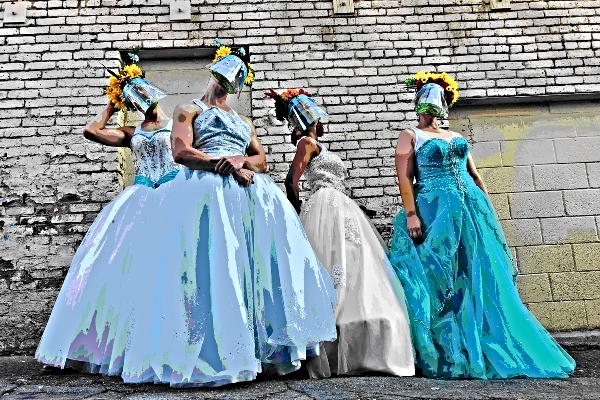
The Primera Generación Dance Collective’s evening-length “Nepantla” occupied the second week of the Dance at the Odyssey Festival at the theater ensemble’s home in West LA. Curated by Barbara Mueller-Wittmann, this company of three collaborating UC Riverside MFA dance grads and a Ph.D. candidate brought their shared experience as Mexican American creatives to the stage.
As the show title is defined in the program as “a space of in-between-ness,” Alfonso Cervera, Rosa Rodriguez-Frazier, Irvin Manuel Gonzalez and Patricia “Patty” Huerta shared movement, games, personal stories, current events, songs (sung on stage and pre-recorded), video and their performance-aware honesty to reveal what it’s like for these artists to live in the United States.
Using a loose yet informed physicality, the quartet layered the aforementioned elements in such a way that, though appearing spontaneous, everything was well thought out. This viewer had many highlights. First, the performers were there, in the moment, on the stage in front of an audience. There were several well-timed glances and comments to the people in the seats at dynamic moments. These gestures almost made fun of what the performers were doing but, instead, acknowledged the proscenium situation and warmly knocked the fourth wall down.
Second, costumes. Credited to the Collective and three others (Isis Avalos, Silvia Echarres De Soto and Samuel Brisbeño Jimenez: custom e-fem-reality), the wardrobe ranged from pop-T-shirts over full-skirted textile collages of Mexican art, bright lights, tulle and earthy colors to red coveralls and dance rehearsal/practice wear. Think a dark gray, Selena-labeled top over a Frida Kahlo portrait in the folds of the lower garment. Similarly, as we hear conventional modern dance aural drones, one can detect the faint sounds of a norteño accordion or the hint of mariachi music. Then the whole group sings different pop tunes simultaneously or Huerta croons the traditional “Cielito Lindo” or “Yankee Doodle” to a dramatic climax.
Third, movement, spoken word and other content. There’s a comic assembly line of gestures creating a chips and salsa dish served in an upside-down straw sombrero, a language interplay amongst the performers in Spanish and English, some male folklorico footwork in shoes, some video of what looks like Covid-masked Latinas at sewing machines while the cast slides on the floor and announces those jobs that immigrants of all backgrounds often take when they first enter the United States.
Unison group dancing was highlighted by changes in staging — dancers moved downstage/upstage to keep the unit interestingly aligned. What may have seemed like a cacophony of unconnected solos, duets and group lifts, these action phrases evolved into a clear diagonal line or a formation audibly labeled as a “po-mo” trope, a compositional device (now too) often used in postmodern dance choreography.
Each of the performers, individually and together, seemed relaxed and comfortable with each other and with the viewers. Toward the end, the foursome invited the onlookers to join them on the stage and move to the exciting mix of Mexican sounds coming through the speakers. The night that this writer attended, 10 folks jumped onto the black marley floor to dance with the company … including a 9-year-old girl. Some of them removed their shoes, and several women and men showed some great club-dancing moves, worth watching on their own.
—Benn Widdey, Culture Spot LA
Photo by Gabriel Gutierrez





